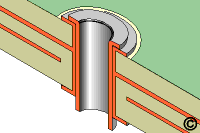No. 5.2
Plated Hole Repair, Double Wall Method
OUTLINE
This procedure covers the use an eyelet for the repair of a damaged
land on a
hole that has an inner layer connect.
CAUTION
This method is used to restore the integrity of a through connection on a
multilayer circuit board, having an inner layer connect, but ONLY if the full barrel
of the plated through hole remains intact. If there is barrel damage see
appropriate procedure.
CAUTION
This method will reduce the inside diameter of the hole. The minimum hole size
requirement must be checked for acceptance.
TOOLS & MATERIALS
Ball Mills
Caliper
Eyelet Press
Eyelets, Various Sizes
Flux, Liquid
Knife
Micro-Drill System
Microscope
Pin Gauges
Plated Hole Repair Kit
Setting Form Tool, Various Sizes
Setting Anvil, Various Sizes
Solder Iron
Solder
Wipes
EYELET SELECTION CRITERIA
ID - Inside Diameter
The eyelet inside diameter should be a .075 - .500 mm (.003"-.020")
greater than the component lead diameter.
LUF - Length Under Flange
The length of the eyelet barrel under the flange should be .630 - .890 mm
(.025" - 035") greater than the thickness of the circuit board. This added
length allows for proper protrusion when setting the eyelet.
FD - Flange Diameter
The eyelet flange diameter should be small enough to prevent interference with
adjacent lands or circuits.
OD - Outside Diameter
The clearance hole drilled through the circuit board should allow the eyelet to be
inserted without force but should not exceed .125 mm (.005") greater than
the eyelet outside diameter.
NOTE
Be sure to select an eyelet meeting the proper criteria. An eyelet with an
oversize flange may interfere with adjacent circuits. An eyelet that is too
short will not protrude through the circuit board for proper setting.
PROCEDURE
- Clean the area.
- Examine the hole to ensure that there is no damage to the wall of the hole.
Check continuity to establish the integrity of the connection.
- Select an eyelet using the Eyelet Selection Criteria. Use a pin gauge and
caliper to measure the existing plated hole dimensions. The eyelet must have an
inside diameter sufficient to receive the component lead and an outside diameter
that will allow the eyelet to be inserted into the hole without force.
- Remove oxides from the surface lands where the eyelet is to be installed
using a buffer and clean.
- Apply a small amount of liquid flux to the land or circuit on the circuit board
surface, if any, and tin with solder using a soldering Iron and solder. Clean
the area.
- Insert the eyelet into the hole. If a new circuit is required, the new
circuit may extend into the hole and the flange of the eyelet will secure the
new circuit in place. (See Figure 1).
- Select the proper setting tools and insert them into the eyelet press. (See
Figure 2).
- Turn the circuit board over and rest the eyelet flange on the lower setting tool.
- Apply firm even pressure to form the eyelet barrel.
- Apply a small amount of liquid flux and solder the eyelet flanges to the
lands on the circuit board surface if necessary. Clean the area. Inspect for good
solder flow and wetting around the eyelet flanges and lands.
- Clean the area.
- Install the component lead and solder, if required.
EVALUATION
- Visual examination, dimensional requirement of land diameter and inside
diameter.
- Electrical continuity measurement.
|
|
|
Solutions Across the Board
TM
|
|
|
|
Product Class: R/F/W
Skill Level: Advanced
Conformance Level: Medium
Revision: F
Revision Date: Mar 28, 2001
Repair Service Charge

Damaged Plated Hole with Inner Layer Connection

Figure 1: Insert the eyelet into the hole.

Figure 2: Set the eyelet using an Eyelet
Press.

Figure 3: Completed repair.
|
Tricks of the Trade
A unique repair\rework method limited to
special applications.
|
|
|





